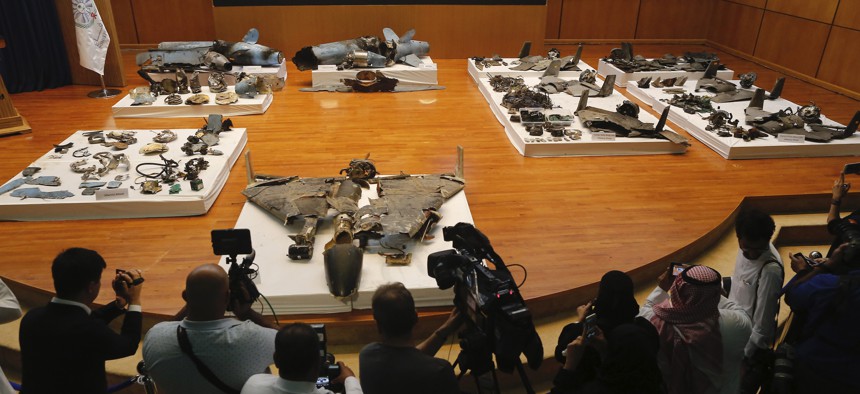
Journalists film what Saudi military spokesman Col. Turki al-Malki said was evidence of Iranian weaponry used in the attack targeted Saudi Aramco's facilities in Abqaiq and Khurais, during a press conference in Riyadh, Saudi Arabia. AP Photo/Amr Nabil, File
Time to Harden International Norms on Armed Drones
Progress on widely accepted rules has been as slow as the technological advancement has been fast.
Drones appear to have been the weapon of choice in last Saturday’s shocking attacks on Saudi oil facilities, a dramatic development in the scale and sophistication of drone attacks even in a year that has seen a substantial escalation in their use.
In Libya, Chinese-made, UAE-operated drones have killed dozens of civilians in support of General Haftar’s militia, while Turkish drones are mounting airstrikes for the UN-backed Government of National Accord. Israeli drones have struck targets in the Egyptian Sinai and in Gaza, and are alleged to have hit an Iranian-backed militia on the Iraqi-Syrian border. In northern Iraq, Turkish drones have targeted Kurdish armed groups, while Iranian surveillance drones have been guiding strikes with short-range ballistic missiles across the Iraqi border at Kurdish militants. And the CIA has built a new airstrip in northern Niger for its clandestine drone operations in the Horn of Africa and the Sahel.
Drones are prized by states and non-state actors alike for their low-cost capability, but also because of the perception that they reduce strategic and operational risk. But studies by the UN Institute for Disarmament Research show how drones can actually increase the risk of escalation, while my own organization’s research outlines how military drones are getting cheaper, smaller and can be flown in swarms to overwhelm enemy defenses. As unmanned aircraft flood the battlespace, we will continue to see increased civilian casualties, attacks on critical infrastructure, displacement, and heightened political tensions, and little way to resolve them.
What’s missing is a clear forum where governments can discuss the rules for making, selling, and operating drones, and where states can be made accountable for their actions. Right now, the liveliest international conversation is about reducing the threat from terrorists armed with commercial drones; some 30 states convened by the United States and Germany are talking about voluntary principles. Unfortunately, little else is currently being done.
The proliferation of drones has no simple solutions, but there are several avenues that might help boost prevention, norms, transparency, and accountability.
Related: How the Pentagon Nickel-and-Dimed Its Way Into Losing a Drone
Related: US Drones May Soon Run on Open-Source Software
Related: Interior Dept. Will Buy Chinese Drones Despite Spy Concerns
First, build norms around lethal drones. States need to clearly outline and articulate their position on international legal principles surrounding the use of lethal drones, particularly in regard to international humanitarian law and international human rights law, as UN Special Rapporteurs, the EU parliament, and international human rights organizations have long pleaded for states to do. They should share their positions in the relevant UN forums, which will strengthen existing interpretations of these legal principles, build a strong norm against stretched interpretations, and ultimately, help hold violators accountable.
Second, help governments better understand what component ought to be more closely restricted. Armed groups and even militaries have long assembled “military-grade” drones from commercial components. In 2012, the Sudanese military used Iranian-designed drones powered by Irish lawnmower engines to guiding artillery onto civilian targets in the Nuba mountains. Yemen’s Houthis hit Saudi airports with long-range kamikaze drones built with Greek and German components.
A group of government officials, defense industry representatives, and other experts should be formed to maintain a working list of drone technologies and components. This will help understand the kinds of products that should be subject to tougher export controls, especially given the frequent blurring of military and civilian drone technology. It could also lead to expanded use of the Wassenaar Arrangement, with just 42 signatories and no enforcement mechanism, and the Arms Trade Treaty, a legally binding pact signed by more than 100 countries.
As well, governments should build a type of “Drone Code,” with strong international standards on the use and export of drone technology, would bolster mutual understanding of the risks involved, and can be used as an instrument for transparency and accountability.
Finally, the UN should guide a wider conversation on 21st-century battlefield dynamics and the role of technology. It’s harder to know how to apply established laws of war because today’s conflicts are so murky, without clearly defined geographic boundaries, combatants, and even goals. A discussion could help us understand where to draw the lines by bringing to light how remote-controlled warfare and other technological trends affect escalation risk, the obfuscation of use of lethal force, and civilian harm. From my experience, I’ve learned that many states are often not aware of such developments and appreciate education and awareness raising. Bringing these wider dimensions and deliberations into the debate, and asking states to reflect on this from their own military expertise could facilitate mutual understanding.
We know multilateral engagement alone will not prevent states and non-states from pursuing their own interests with any means they deem necessary. But, to prevent attacks like the one we saw in Saudi Arabia, or in Lebanon and Syria before that, those using military drones must step up and adhere to the standards of recognized international legal principles and clarify their position how they use lethal force. On the other side, those states developing and exporting military drones should clearly outline the risks associated with misuse to prevent drone technologies from ending up in the wrong hands, or in a worst-case scenario, be used against them. Without these types of restraint and regulation policies, the drone wars will soon come home. No one wants that.